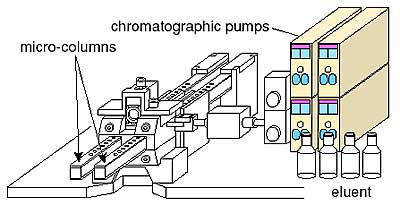Discovery of new elements and study of the chemistry of the heaviest elements are among the most interesting and challenging subjects in the field of basic chemistry, especially of nuclear and radiochemistry. Up to now, we have knowledge of 114 chemical elements, of which 22 are man-made transuranium elements. The first 11 artificial elements beyond uranium belong to the actinide series. Element 104, rutherfordium (Rf), marks the beginning of a remarkable series of chemical elements, the transactinide elements. One of the most important and most interesting questions for a chemist is that of the position of the transactinide elements in the periodic table of the elements.
Because of the many challenges in performing chemical studies of the transactinide elements, certain technical capabilities are required. The transactinide elements must be produced by bombardment of radioactive transuranium targets with high-intensity, accelerator-generated heavy ion beams, and must be identified by measurement of their radioactive decay using unambiguous detection techniques. Because of the short half-lives and low production rates, each transactinide atom produced decays before a new atom is synthesized. This means that any chemistry to be performed must be done with single atoms on a "one-atom-at-a-time" basis. Thus, rapid, highly efficient, and selective chemical procedures are indispensable to isolate and to study the chemical properties of any desired transactinide element.
Recently, newly developed experimental apparatus has come on line for the study of Rf chemistry, including a gas-jet transport system, an on-line alpha-ray detection system for the decay of Rf nuclei, and an automated, rapid chemical separation apparatus based on high-performance liquid chromatography. The rutherfordium isotope 261Rf (half-life: t1/2=78 s) has been successfully produced by bombardment of a curium target (248Cm) with an oxygen beam (18O) delivered from the JAERI tandem accelerator. The production rate was 2 atoms per minute. Ion-exchange experiments on Rf in acidic solution have been conducted more than one thousand times with a gas-jet coupled, automated, rapid ion-exchange separation apparatus (Fig. 4-5). Fig. 4-4 shows the adsorption behavior of Rf, zirconium (Zr), and hafnium (Hf) as a function of HCl concentration. The result clearly indicates that the absorption behavior of Rf is quite similar to that of the group-4 elements like Zr and Hf. Thus, Rf appears to be a member of the group-4 elements. |


